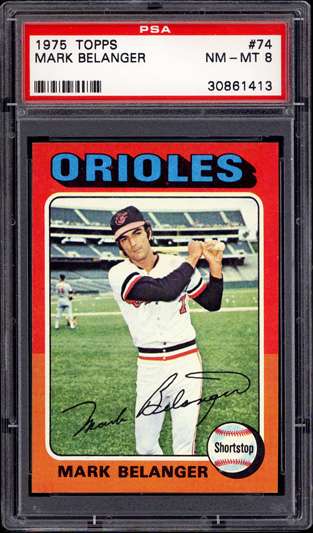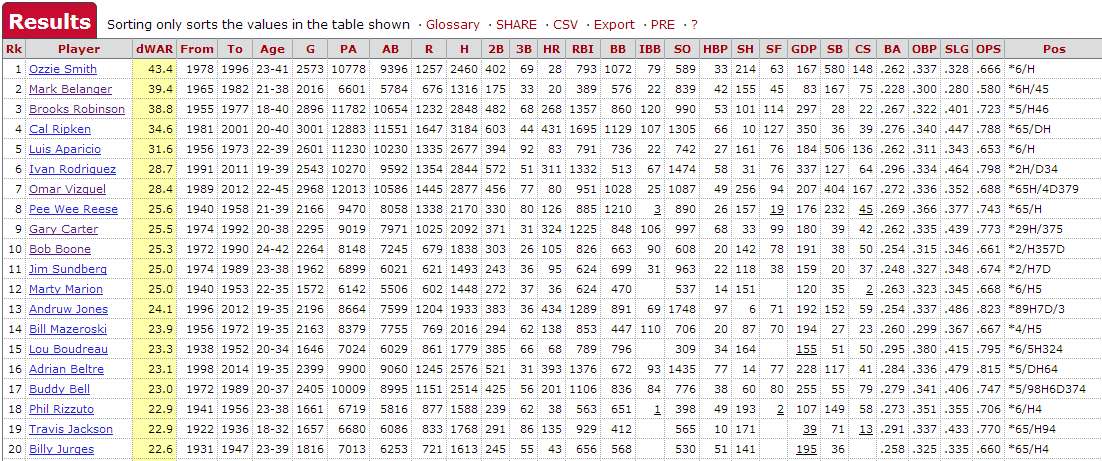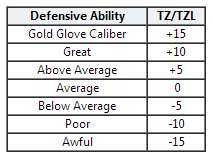Mark Belanger, shortstop
Mark Henry Belanger (The Blade)
Baltimore Orioles (1965-1981)
Los Angeles Dodgers (1982)
 Career stats
Career stats

Leading off this discussion with perhaps the very worst hitter of the modern era as my choice for most deserving of Cooperstown induction may seem strange. But make no mistake about it. Mark Belanger is worthy of the Hall of Fame. That he is not there is a monumental oversight by the Baseball Writers and the Veterans Committee.
 My 1975 Topps Mark Belanger.
My 1975 Topps Mark Belanger.
I've long felt that the Baseball Hall of Fame was offense biased. If you were a career .330 hitter with 2,500 hits and a few MVPs, you were in. For the longest time, if a player reached the 3,000 hit plateau, or hit 500 home runs, they were virtually assured that the Baseball Writers were going to elect them after the mandatory 5 year waiting period had been met. But then again, offense has always been easier to study than defense. The number of home runs, or runs batted in a hitter tallied in one season was easy to track. Defense has always been harder to measure. You might know a great play when you see it, but in the boxscore, it just showed up as an out. Brooks Robinson makes a spectacular play at third on a ball slicing down the line in the 1970 World Series against the Cincinnati Reds, and throws the ball all the way across the field to the first baseman for the out. One of the truly iconic plays in the history of baseball. The box score shows it as a 5-3 groundout. You could say "wow", but there was really no way to quantify how good he was. The statistics used to measure defense were woefully inadequate. Assists, double plays, fielding percentage. If you didn't make any mistakes, you could end the season with a 1.000 fielding percentage. Fielding percentage actually seemed to penalize the best fielders. Some balls could not be caught. Some the truly great shortstops, or second basemen, tried to get, but could not turn into an out. Those might have been ruled an error by the official scorekeeper. Nevermind that the ball was a full three steps to the right of the shortstop, and mere mortal men would not have even gotten to the ball. But the great defenders were all too often overlooked. Some of the great defenders were also great hitters. Clemente won batting titles. In his prime, Brooks Robinson hit enough to win an MVP. Curt Flood, in his prime, was a .300 hitter with a little power, and a little speed. But some of the very best fielders were not great hitters, and so they were overlooked when it came time to hand out awards. They were forgotten when it came time to vote for the Hall of Fame.
Mark Belanger was a bad hitter. A really bad hitter. How bad? Of all the hitters with 5,000 or more at bats in the modern era (1920 to today), Belanger had the lowest OPS of all. OPS, of course, combines OBP (on base percentage) with SLG (slugging percentage), or power. Nobody did both getting on base and hitting for power worse than Mark Belanger.

Belanger appeared on the 1988 Hall of Fame ballot, and only received 3.7% of the vote. He did not meet the minimum threshold to stay on the ballot (5%). So, that was it. In 1988, Sabermetrics did not exist. The members of the BBWAA (Baseball Writers of America) only had Belanger's putrid offensive numbers, and the most basic of defensive metrics to go off of. And they knew he had 8 Gold Gloves. Well, Brooks Robinson, who was to his right, had sixteen Gold Gloves, so clearly, Belanger benefitted from Robinson's presence. Since he couldn't hit, and since 8 Gold Gloves was good, but not really great, especially considering who played alongside of him, Belanger's Hall of Fame eligibility was basically discarded.
What if I were to tell you that in the history of baseball, Mark Belanger had the second highest dWAR of all-time? dWAR is
Defensive Wins Above Replacement. Click the link if you need an explanation of what WAR is, and how it's calculated. The only player with a higher dWAR than Mark Belanger is Ozzie Smith. More on that in a minute.
In the history of Major League Baseball (modern era 1920 to present), there have only been 25 players to compile a career dWAR of 20 or higher. The list that follows shows the truly elite defensive players in the game's history.

If you look at this list, you will see that Brooks Robinson, Belanger's teammate, ends up one slot below Belanger. And again, Ozzie Smith is the only player to have a higher career dWAR than Belanger. But compare the dWAR of these players to the number of games played. Ozzie Smith's dWAR is a full 4 points higher than Belanger's. But Smith also played in 557 more games. That's nearly three and a half more years.
So, to figure out which player truly had the biggest defensive impact from this list, I took the career games played total for each player, and divided by 162. The total seasonADJ figure tells me how many standardized 162 game seasons each player completed in his career. I took their career dWAR figures and divided by the number of standardized 162 game seasons. Mark Belanger is not only the best on this list, he is #1 by a comfortable amount. He averaged nearly a half dWAR more per season than Smith.

When you look at these figures, it's no surprise at all that the Baltimore Orioles were consistently among the elite teams in baseball in the late 60s and early to mid 70s. If you look at the number of Gold Gloves Oriole infielders won between 1969 and 1975, their success isn't surprising.
Brooks Robinson 7 at third base
Mark Belanger 5 at shortstop
Davey Johnson 3 at second base
Bobby Grich 3 at second base
Baltimore Oriole players won 18 of a possible 21 Gold Gloves at the 3 double play positions. Of course, Brooks Robinson won 9 other Gold Gloves. Before they had Mark Belanger, the Orioles had Luis Aparicio at shortstop, and he won two Gold Gloves for the Orioles, in 1964 and 1967. The Orioles easily had one of the best defensive infields in baseball history.
We can look at other metrics that show how great Belanger was. Total Zone Runs, for one, indicates how many runs above or below average a defensive player was worth. Belanger's 35 Total Zone Runs in 1975 is listed as the second best total ever for a shortstop. I question the accuracy of the single season leader. Adam Everett is listed as being worth 40 runs above average in 2006. His second best total in any season was 10 runs above average in 2004. He never had more than 6 in any other season. I'm not contending it's wrong, but that possibility exists. But back to Belanger. This means Belanger's defense saved 35 runs more than the average shortstop in 1975. Belanger led the American League in Total Zone Runs eight times, in 1968, 1971, and ever season from 1973 to 1978. His 238 Total Zone Runs career total is second best all-time, 1 behind Ozzie Smith, who we have already established played some 550 more games than Belanger. Clearly, Belanger is the best shortstop in baseball history at saving runs when time played is considered as a factor. Remember, these figures represent above or below
average. If I am interpreting this correctly, Mark Belanger, over the course of his career, saved 238 more runs than an average shortstop would have over the same period of time.
Per Fangraphs, Total Zone ratings break down into tiers. League average would be zero. Positive scores represent above average fielding, negative scores below average fielding.

Belanger, clearly, was exceptional, scoring above 15, the Gold Glove threshold, seven times.
Still other methods of assessing Belanger's true greatness exist. Range factor being one. Range factor measures a defender's contribution to a team's defense. It calculates putouts and assists per 9 innings. It takes the exact opposite approach to fielding percentage, which calculates how cleanly a fielder handles the balls he makes a play on. Range factor rewards players with range because, theoretically, they will get to more balls than somebody with less range. Range can be derived from different factors-reflexes, instincts, speed, and athleticism. Simply put, if two shortstops are compared, the one with the higher range factor is making a greater contribution towards his team's success by getting to, and making more plays.
Mark Belanger's range factor per 9 innings is the 4th best all-time by a shortstop at 5.241. Interestingly, the highest range factor/9 IP by a Hall of Famer is 5.215 by Ozzie Smith, who is fifth all-time. Robin Yount, seventh all-time, has the second highest range factor per 9 innings by a shortstop at 5.132.
Baseball Reference's Career Leaders & Records for Range Factor per 9 innings as a shortstop
There are yet other ways of measuring Belanger's defensive contributions, some of which require thinking outside of the box. One such method would be to examine the number of twenty game winners the Orioles had during Belanger's career.
In order for a starting pitcher to win twenty games in a season, they must, of course, remain healthy. They must have an offense to provide run support for them. But most importantly, a successful pitcher should try to limit the number of base runners they allow, as fewer base runners will invariably lead to fewer runs scored. A great defense behind a pitcher will go a long way towards helping them win 20 or more games. During the time when Belanger and Brooks Robinson paired as full time starters, which was from 1968 to 1975, Robinson won all eight of the Gold Gloves that were awarded. Mark Belanger won 5 of the 8 Gold Gloves, losing out to Luis Aparicio in 1968 and 1970, and Detroit Tiger Ed Brinkman in 1972.
During this eight year span, the Orioles were incredibly successful. They won their division 5 times, won the American League pennant in 1969, 1970 and 1971, and won the World Series in 1970. And Baltimore's rise to greatness coincided with Belanger's winning the starting job. In 1967, Belanger played only 69 games. The Orioles were 76-85, and finished 6th in the American League. However, the Orioles were 36-33 that year in the games Belanger played. In 1968, the O's improved to 91-71, 2nd place in the American League. The next three seasons, the Orioles won 109, 108 and 101 games. While Belanger's bat had little to do with their success, there is no doubting that Belanger's presence helped to make the team a winner. And there's little doubt, too, that his exceptional defense helped many of the starting pitchers for Baltimore realize unprecedented success. Of the pitchers to win 20 games at one point or another for Baltimore, Jim Palmer was truly the only star of the bunch. He was the Hall of Famer. But there were a lot of other 20 game winners because the team behind them was exceptional. Here's a breakdown of the Baltimore Oriole 20 game winners between 1968 and 1975.
1968: Dave McNally (22-10)
1969: Mike Cuellar (23-11), Dave McNally (20-7)
1970: Jim Palmer (20-10), Mike Cuellar (24-8), Dave McNally (24-9)
1971: Mike Cuellar (20-9),Pat Dobson (20-8),Jim Palmer (20-9), Dave McNally (21-5)
1972: Jim Palmer (21-10)
1973: Jim Palmer (22-9)
1974: Mike Cuellar (22-10)
1975: Jim Palmer (23-11), Mike Torrez (20-9)\
Mike Cuellar was a very good pitcher. He went 185-130, ending with a .587% lifetime winning percentage, and a 3.14 ERA. He won the 1969 Cy Young Award. Dave McNally went 184-119 for a career .607 winning percentage. He ended with a 3.24 ERA. Pat Dobson ended up with a 122-129 career record, and a 3.54 career ERA. After winning 20 games for the Orioles in 1971, he eventually ended up with the New York Yankees. He won 19 games for New York in 1974. Mike Torrez went 185-160 in his career, a .536 winning percentage. He had a 3.96 career ERA. Jim Palmer went 268-152 in his career, good for a .638 winning percentage. Palmer spun an outstanding 2.86 ERA for his career, on his way to 3 Cy Young Awards and election to the Baseball Hall of Fame. Palmer himself added 4 Gold Gloves to his resume.
In total, between 1968 and 1975, the Baltimore Orioles had 15 20 game winners. While it's impossible to know just how many of those games were won because of a play made by any individual defender, the defense the Orioles had was stifling. And Belanger, having a higher dWAR per 162 games played than any other defender in baseball history, with the 4th highest shortstop range factor in baseball history, with the second best total zone rating by a shortstop in baseball history (and only 1 point behind Ozzie Smith, who played 550 + more games), was one of the biggest factors in Baltimore's success. He didn't do much with the bat, though he did contribute occasionally. He hit a home run in the first ever American League Championship series game in 1969. He hit .333 in the 1970 ALCS, helping his team get to and ultimately win the World Series. But it was his glove, his brilliant defensive play that ended one rally after another, that helped his team every single game. Unlike a hitter, who can have a cold streak, a great defender contributes every single game they play. And Belanger, who may be the greatest single defensive player in the game's history, should be enshrined in Cooperstown.
Players have been enshrined for their offensive prowess only. It is commonly held that Ted Williams was a below average outfielder. He was constantly distracted, thinking about his next at bat. His Hall of Fame induction was based solely on his offensive acumen. Why then should a player not make it to Cooperstown only because of his defensive abilities? Belanger didn't have slumps in the field. While a hitter might only have one or two hits in a game, a shortstop makes several plays each game. How many double plays did Belanger turn in his career? 1,054. He led the American League in assists three times between 1973 and 1976, and the other season he was second in assists. And even with his incredible range, even when he got to balls that other shortstops simply couldn't get to, he didn't make mistakes. Between 1974 and 1978 he led the American League in fielding percentage three times. In the other seasons he was second or third. Belanger was a black hole at shortstop. Balls were hit in his general direction, and rallies were never heard from again. Cal Ripken Jr, a Hall of Famer himself, credits Belanger with teaching him the nuances of the position. Ripken said that Mark Belanger taught him how to turn the double play.
 The Blade sends another hitter to the dugout.
The Blade sends another hitter to the dugout.
When a player can be called the very best ever in Major League history, they deserve to be in the Hall of Fame. He may not have been potent with his bat, but defense is half the game, and Belanger was as good at shortstop as anybody who has ever played the position.